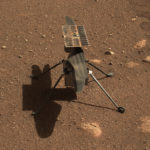Today marks the 60th anniversary of the first flight into space by Russian cosmonaut Yuri Gagarin and the 40th anniversary of the first NASA space shuttle flight.
The cosmic alignment of these two milestones is actually something that can be blamed on computer error. The world’s first re-useable spacecraft was supposed to have launched from the Kennedy Space Center two days earlier on April 10, 1981. Instead, the technical hitch led to NASA’s space shuttle Colombia being launched 20 years to the day that Russian Yuri Gagarin became the first human to fly into space.
On April 12, 1961, Soviet cosmonaut Yuri Gagarin launched into space aboard Vostok 1. Gargarin completed one orbit around Earth in one hour and 48 minutes before the rocket’s automatic controls brought him back into the atmosphere. He parachuted down from the spacecraft at 20,000 ft near the Russian village of Smelovka.
Vostok 1 was designed by Soviet engineer Sergei Pavlovich Korolev, who had built and tested rockets over several years and had previously sent up dogs and other animals into space. The mission to send Gagarin into orbit was not without its tricky moments – the team on Earth lost radio contact with the former Soviet Air Force pilot for 23 minutes during the flight.
NASA’s shuttle programme spanned 30 years
Today also marks the first voyage of NASA’s Space Shuttle Columbia, on April 12, 1981. Astronauts John Young and Robert Crippen were aboard the spacecraft which took off from launch pad 39A at Kennedy Space Center with astronauts John Young Robert Crippen aboard.
Columbia’s debut mission marked the first flight in a 30 year programme which was marked by triumphs and tragedies. Shuttle commander Young, who had already made five trips into space said: “It was worth the wait. The vehicle is performing just like a champ. It was as smooth as it possibly could go . . . better than anyone expected on the first flight.”
Columbia’s debut mission would be the first of 135 for the $10 billion shuttle programme. The reusuable spacecraft were able to carry a crew of seven astronauts or 10 in an emergency. NASA’s five shuttles placed the Hubble Space Telescope into orbit and delivered the majority of the modules for the International Space Station.
But the programme also suffered catastrophic losses: Challenger exploded during launch in 1986 and Columbia – which had blazed a trail for human spaceflight – was destroyed during its return to Earth on its 28th mission in 2003. Both crashes killed the shuttles’ seven-strong crews. The programme ended on July 21, 2011, when Atlantis touched down at the Kennedy Space Center.
New countries, new players, new issues to be solved
Today, space no longer remains the preserve of a space race between two states. But as more countries and more companies become involved in this new frontier of commercial spaceflight, there are new issues to solve. Volodymyr Leveykin is the CEO and founder of Skyrora, a UK rocket startup which aims to make spaceflight more sustainable.
Skyrora is using 3D printing in the manufacture of its rockets, but has also developed a new sustainable rocket fuel, Ecosene which is made from waste plastic. The company claims that Ecosene could remove more than 3,000 tons of unrecyclable plastic by 2030.
Skyrora is also helping tackle the growing issue of “space junk” as greater numbers of satellites are deployed into orbit. It also recently completed tests of a new reusable “space tug” which can tow decommissioned satellites out of orbit. The space startup has received funding from the European Space Agency to support its bid to become the first company to make an orbital launch from UK soil.
Saving Earth – today’s space race
Leveykin, CEO said: “As we mark an historic day for the space sector, it is important to reflect not only on how far it has come but also on the direction in which it is heading. The world was a very different place 60 years ago when Yuri Gagarin became the first human in space, or even 40 years ago when the NASA space shuttle first launched. Today, the biggest space race isn’t about the Moon or even Mars, it’s a race against time to tackle climate change and preserve our planet.”
He added: “The sustainability efforts made by space companies and organisations shouldn’t just be limited to things that everyday people can’t typically see. There has been significant progress in the UK around using otherwise non-recyclable waste plastic, such as polystyrene, as a more eco-friendly aviation fuel, potentially removing thousands of tonnes of waste plastic from communities that would otherwise end up in landfill. Perhaps in another 40 years, as the sector continues to address environmental challenges here on Earth, we will look back on this period as the beginning of space efforts turning the tide on climate change.”

